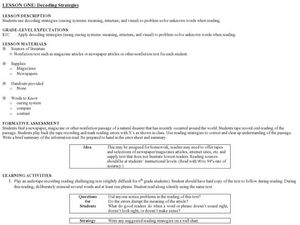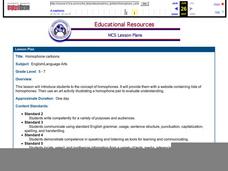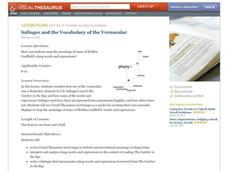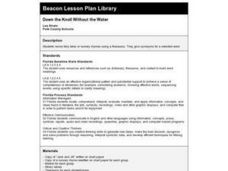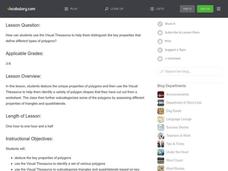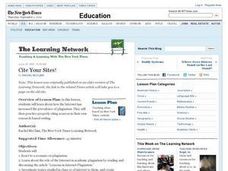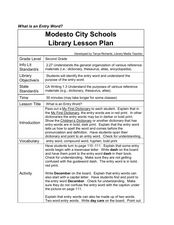Curated OER
Lesson 5:Web Page
Students create a webpage. In this technology lesson, students choose a topic and work in groups to create their own webpage using Microsoft Frontpage. This lesson includes directions on how to make webpages and cover pages.
Curated OER
Shades of Meaning
Examine and distinguish between words that have similar definitions but different connotations. Middle schoolers define connotation and denotation and participate in a "shades of meaning" contest in small groups. Groups use the...
Curated OER
Writing Myths I
Explain a natural phenomenon in an original myth. After researching the phenomenon they have chosen, young readers use factual information to include in their myth. They find synonyms and new phrases to create vivid images as they...
Curated OER
Creative Writing Using the Senses
Fifth graders, utilizing a thesaurus to identify alternative word choices and meanings, eat a sweet treat and then list eight different adjectives for each of the five senses. They then describe a sweet with at least then adjectives...
Curated OER
Mammal's Around the World
Fifth graders, exploring all the ins and outs of using a computer, publish their own mammal papers with the use of word searches, thesaurus and spell checks. While in the computer lab, they research their mammal and country on the...
Curated OER
Lesson One: Decoding Strategies
Review decoding strategies to read a chosen text. Readers tape themselves reading out loud, listen to the recording, and mark where they have misread words or phrases. They then discuss which words were misread and review how to correct...
Curated OER
Homophone Cartoons
A terrific lesson on homophones awaits your youngsters. First, pupils access a website that contains lists of homophones. Then, it's time to get creative! Everyone gets a piece of poster board and they create a homophone cartoon -...
Curated OER
Musical Change
Young learners record observations about different coin denominations and create a song about coins to the traditional song, "The Wheels on the Bus." This lesson is based on the Tennessee Quarter Reverse, and has all sorts of excellent...
Curated OER
Salinger and the Vocabulary of the Vernacular
Writers explore vocabulary and expressions used in the English language. They use visual word maps to become aware of the different uses of words which will allow them to more readily interpret texts. Then they listen to/read excerpts...
Curated OER
Down the Knoll Without the Water
Students use a thesaurus to find synonyms for selected words in fairy tales.
Curated OER
"To Be Or Not To Be" And the VT
Using the online Visual Thesaurus, nascent actors work in groups to analyze and interpret Hamlet's "To Be Or Not To Be" monologue. Individuals then craft a contemporary version of this famous speech and present their adaptation...
Curated OER
The Continents and Oceans of the World
Students explore world mapping skills. In this world geography instructional activity, students identify and label the continents and oceans on a world map using the Visual Thesaurus. Students generate mnemonic devices to help memorize...
Curated OER
On-Line Homework Help: An Ethical Dilemma
Students use a visual thesaurus and Vocabgrabber to interpret a news article. In this vocabulary building and comprehension lesson, students analyze quotes from the article. Students use the visual thesaurus and Vocabgrabber to interpret...
Curated OER
Using Key Words to Unlock Math Word Problems
Young scholars act as math coaches to solve word problems. In this math word problems lesson, students brainstorm key words in math operations, create flash cards to review relationships between words and operations, coach each other in...
Curated OER
Making Sense of Homographs
What is a homograph? Develop your students' vocabulary with a word association tool. Language arts classes discover what a homograph is and how it can be used as a visual thesaurus. They discover the other uses for homographs...
Curated OER
Know Your Polygons!
Young scholars identify and categorize different polygons. In this polygons lesson plan, students research and identify properties of polygons, identify different polygon shapes, and categorize different triangles and quadrilaterals.
Curated OER
Figurative Language in Toni Morrison's "A Mercy"
In order to read and respond to Toni Morrison's A Mercy in this figurative-language instructional activity, students discuss the differences between a literal and a figurative interpretation of a text. They explore figures of...
Curated OER
Take the Prefix Challenge
Students form words using prefixes. In this prefix lesson, students compete in a "prefix challenge" to see which team can combine a set of twelve prefixes with a set of twelve words fastest. Students enter their words in...
Curated OER
Cite Your Sites
What information would you find in an almanac that you would not find in an atlas? What is the difference between a dictionary and a thesaurus? Using a Cite Your Sites worksheet on which they record their observations, groups participate...
Curated OER
Dictionary Work - Entry Words
Second graders examine the use of entry words in the dictionary. In this dictionary use instructional activity, learners look at guide words in a children's dictionary as the teacher/librarian describes the characteristics of each entry....
Curated OER
Nym Family
List and identify words for each part of the "Nym" family: synonyms, antonyms and homonyms. Middle schoolers place words in the correct category, then find the corresponding mate in a dictionary or thesaurus.
Curated OER
Writing: Narrative, Expository, Persuasive, and Descriptive
If you are interested in having a basic framework for teaching expository, narrative, persuasive, and descriptive writing, this resource may help; however, you will have to find information on the different forms of writing to share with...
Curated OER
Word Reference Materials
A class discussion on reference materials opens up a activity on how to use these important resources. They discover that dictionaries, glossaries, and thesauruses are called word reference resources, and they practice using them. The...
EngageNY
Resource Materials and Gathering Information: Reading Another “Choice” Text from the Research Folder
Look it up. Scholars use a dictionary and thesaurus to verify the meaning of the research vocabulary words they defined in the previous activity. They then use sticky notes to write a synonym for each word. Finally, individuals choose a...







